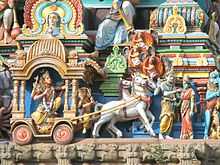Gopuram

A Gopura (singular) (Sanskrit: गोपुर) or Gopuram (plural) (Tamil: கோபுரம்), is a monumental tower, usually ornate, at the entrance of any temple, especially in Southern India. This forms a prominent feature of Koils, Hindu temples of the Dravidian style.[1] They are topped by the kalasam, a bulbous stone finial. They function as gateways through the walls that surround the temple complex.[2]
The gopuram's origins can be traced back to early structures of the Tamil kings Pallavas; and by the twelfth century, under the Pandya rulers, these gateways became a dominant feature of a temple's outer appearance, eventually overshadowing the inner sanctuary which became obscured from view by the gopuram's colossal size.[3] It also dominated the inner sanctum in amount of ornamentation. Often a shrine has more than one gopuram.[4] They also appear in architecture outside India, especially Khmer architecture, as at Angkor Wat.
A koil may have multiple gopurams, typically constructed into multiple walls in tiers around the main shrine. The temple's walls are typically square with the outer most wall having four gopura-vimanas, one each on every side, situated exactly in the center of each wall. The sanctum sanctorum and its towering roof (the central deity's shrine) are also called the vimanam. Generally, these do not assume as much significance as the outer gopurams, with the exception of a few temples where the sanctum sanctorum's roofs are as famous as the temple complex itself. The Ananda Nilayam gopuram-vimanam of the Tirumala Venkateswara Temple is a famous example where the gopuram of the main shrine occupies a very special place in the temple's history and identity.
Etymology
The Sanskrit word, गोपुर, is often translated as "town gate". Separately, it consists of two words go, with the possible meanings of "cow" or "sky", and pura, meaning city.[5] The word was borrowed into Tamil where it is pronounced kopuram and given a folk etymology of derivation from the two words: கோ (Kō) and புறம் (puram) meaning 'King' and 'exterior' respectively.[6] It originates from the Sangam age when it was known as ஓங்கு நிலை வாயில் (ōngu nilai vāyil) meaning 'Imperishable gateway'.[7] Adhering to the orthodox grammar of sankattamiḻ (Classical Tamil), it would be pronounced koh-puram as the velar is always voiceless in the Tamil language.
Architecture

A gopuram is usually rectangular in form with ground-level wooden doors, often richly decorated, providing access. Above is the tapering gopuram, divided into many storeys which diminish in size as the gopuram tower narrows. Usually the tower is topped with a barrel vaulted roof with a finial.[3]
The form began rather modestly in the 10th century, as at Shore Temple, Mahabalipuram, with the 11th century Brihadeeswarar Temple in Thanjavur marking a crucial step forward with two multi-storey gopurams from that period, much larger than any earlier ones, though much smaller than the main tower of the temple. The four gopurams of the Thillai Nataraja Temple, Chidambaram are important early examples, begun in the mid-13th century but completed over a longer period.[8]
Gopurams are exquisitely decorated with sculpture and carvings and painted with a variety of themes derived from the Hindu mythology, particularly those associated with the presiding deity of the temple where the gopuram is located.
Examples
The Gopurams of Tamil Nadu built centuries ago were urban nodes and focal points of their surrounding towns. The Sri Ranganathaswamy Temple in Srirangam, Tamilnadu state is the tallest Hindu Gopuram in Tamil Nadu (built in 1980's). This Gopuram, known as the Rajagopuram (the royal temple tower), rises from the base area of around 13 cents (32500 sq ft) and goes up to 196 feet (60 m), moving up in eleven progressively smaller tiers. The 'Rajagopuram' Gopuram of Murudeshwara in Karnataka (built in 2007) is 237.5-feet tall and 20 floors is the tallest Gopuram in the world. The magnificent 123-feet long statue of Lord Shiva in the backdrop.However both of these two gopurams (Srirangam and Murudeshwara)are not ancient monuments. The Meenakshi Amman Temple Gopuram in Madurai also built in the 16th century, and the Gopuram of Sri Andal Temple in Srivilliputtur are some of the notable Temple towers.
-

Murdeshwar temple gopuram
-
.jpg)
Srirangam Ranganathaswamy Temple gopuram
-

Andal Temple gopuram
-

Vijayanagar styled Raya Gopura of Virupaksha Temple, Hampi
Gallery
-
Tirumala Venkateswara Temple gopura
-

Gopura of the Virupaksha Temple at Hampi
-

Gopuram and modern tower in Singapore
-

Gopuram of the Annavaram temple at Annavaram
-
Side view Govindaraja swamy Gopuram at Tirupati
-

Entrance, with gopura, of Athi Koneswaram temple, Thampalakamam, Trincomalee, Sri Lanka
-

Top of a gopuram at Madurai
-

Gopura of Nanjangud Temple at Night, Nanjangud
-

Subhramanya Swamy Temple in Biccavolu
-

Chebrolu Temple Gopura
See also
Notes
- ↑ Ching et al., Francis D.K. (2007). A Global History of Architecture. New York: John Wiley and Sons. p. 762. ISBN 0-471-26892-5.
- ↑ Ching, Francis D.K. (1995). A Visual Dictionary of Architecture. New York: John Wiley and Sons. p. 253. ISBN 0-471-28451-3.
- ↑ 3.0 3.1 Mitchell, George (1988). The Hindu Temple. Chicago: University of Chicago Press. pp. 151–153. ISBN 0-226-53230-5.
- ↑ "gopura". Encyclopædia Britannica. Retrieved 2008-01-20.
- ↑ Lienhard, Siegfried; von Hinüber, Oskar, eds. (2007). Kleine Schriften [Collected Writings] (in German). Harrassowitz Verlag / Glasenapp-Stiftung. ISBN 9783447056199. Retrieved 5 February 2014.
- ↑ Sellby, Martha A.; Indira Viswanathan Peterson (2008). Tamil geographies: cultural constructions of space and place in South India. SUNY Press.
- ↑ S. Sundararajan (1991). Ancient Tamil country: its social and economic structure. Navrang.
- ↑ Harle, 320-325
References
Dallapiccola, Anna L. (2002). Dictionary of Hindu Lore and Legend. London: Thames & Hudson. ISBN 0-500-51088-1.
- Harle, J.C., The Art and Architecture of the Indian Subcontinent, 2nd edn. 1994, Yale University Press Pelican History of Art, ISBN 0300062176
External links
| Look up gopuram in Wiktionary, the free dictionary. |
| Wikimedia Commons has media related to Gopurams. |

